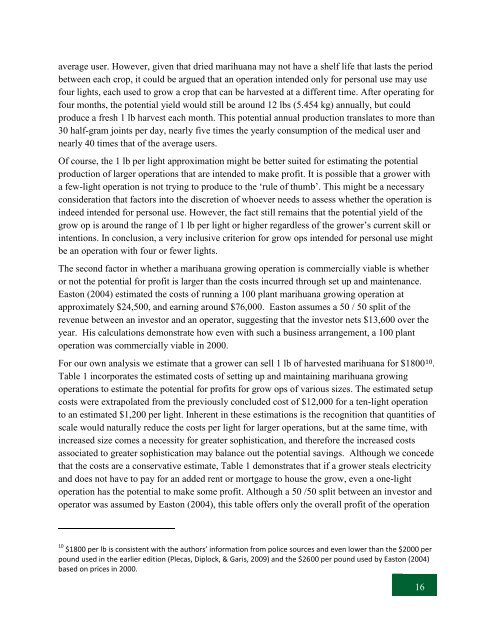Comercial+Grow+Op
Comercial+Grow+Op
Comercial+Grow+Op
Create successful ePaper yourself
Turn your PDF publications into a flip-book with our unique Google optimized e-Paper software.
average user. However, given that dried marihuana may not have a shelf life that lasts the period<br />
between each crop, it could be argued that an operation intended only for personal use may use<br />
four lights, each used to grow a crop that can be harvested at a different time. After operating for<br />
four months, the potential yield would still be around 12 lbs (5.454 kg) annually, but could<br />
produce a fresh 1 lb harvest each month. This potential annual production translates to more than<br />
30 half-gram joints per day, nearly five times the yearly consumption of the medical user and<br />
nearly 40 times that of the average users.<br />
Of course, the 1 lb per light approximation might be better suited for estimating the potential<br />
production of larger operations that are intended to make profit. It is possible that a grower with<br />
a few-light operation is not trying to produce to the ‘rule of thumb’. This might be a necessary<br />
consideration that factors into the discretion of whoever needs to assess whether the operation is<br />
indeed intended for personal use. However, the fact still remains that the potential yield of the<br />
grow op is around the range of 1 lb per light or higher regardless of the grower’s current skill or<br />
intentions. In conclusion, a very inclusive criterion for grow ops intended for personal use might<br />
be an operation with four or fewer lights.<br />
The second factor in whether a marihuana growing operation is commercially viable is whether<br />
or not the potential for profit is larger than the costs incurred through set up and maintenance.<br />
Easton (2004) estimated the costs of running a 100 plant marihuana growing operation at<br />
approximately $24,500, and earning around $76,000. Easton assumes a 50 / 50 split of the<br />
revenue between an investor and an operator, suggesting that the investor nets $13,600 over the<br />
year. His calculations demonstrate how even with such a business arrangement, a 100 plant<br />
operation was commercially viable in 2000.<br />
For our own analysis we estimate that a grower can sell 1 lb of harvested marihuana for $1800 10 .<br />
Table 1 incorporates the estimated costs of setting up and maintaining marihuana growing<br />
operations to estimate the potential for profits for grow ops of various sizes. The estimated setup<br />
costs were extrapolated from the previously concluded cost of $12,000 for a ten-light operation<br />
to an estimated $1,200 per light. Inherent in these estimations is the recognition that quantities of<br />
scale would naturally reduce the costs per light for larger operations, but at the same time, with<br />
increased size comes a necessity for greater sophistication, and therefore the increased costs<br />
associated to greater sophistication may balance out the potential savings. Although we concede<br />
that the costs are a conservative estimate, Table 1 demonstrates that if a grower steals electricity<br />
and does not have to pay for an added rent or mortgage to house the grow, even a one-light<br />
operation has the potential to make some profit. Although a 50 /50 split between an investor and<br />
operator was assumed by Easton (2004), this table offers only the overall profit of the operation<br />
10 $1800 per lb is consistent with the authors’ information from police sources and even lower than the $2000 per<br />
pound used in the earlier edition (Plecas, Diplock, & Garis, 2009) and the $2600 per pound used by Easton (2004)<br />
based on prices in 2000.<br />
16


